Traveling is a great opportunity to experience new things and learn about various cultures. When visiting a certain country or region, travelers always long to sample the local cuisine because it is the height of color.
You’re here because you want to organize a trip to Vietnam and experience the local food, am I accurate? Therefore, believe us when we say that the list of 15 Vietnamese meals below is one that any native will like. These dishes have distinctive flavors that are unique to Vietnam and that you will not be able to find at a second place in this vast globe.
1. Cơm Lam (Bamboo cooked rice)
Vietnamese sticky rice in bamboo, or Com Lam, is a delicacy of ethnic minorities in the Central Highlands and Northwestern Vietnam, including the Thai, Muong, Nung, Tay, La Ha, and Mang.
It is prepared with rice or sticky rice in a bamboo tube and served with grilled wild boar skewers or a sauce made of roasted sesame, peanuts, and salt. Nothing, according to the locals, compares to enjoying Com Lam while conversing with friends and drinking some Ruou Can (Straw Wine).

Glutinous rice is used to prepare this meal. Lam rice is an intriguing dish since it is prepared differently from other Vietnamese cuisines in the west and is connected to the idea of forest and mountain children. When cooking rice, the grains are placed in a bamboo or cork tube, mixed with other ingredients, and baked over an open flame.
Even now, this simple meal has grown in popularity. In addition to being a favorite cuisine, Com Lam is revered as the essence of the people. Com Lam’s demonstration of his culinary prowess is frequently the center of attention during festivals in order to draw foreign guests and educate them about the distinctive dishes and vibrant culture of Vietnamese cuisine.
2. Phở (Rice noodles)
Many histories in Vietnam are influenced by legends and myths, giving them a wide range of hues. The most popular dish and most lucrative culinary export of the nation, phở, is also like this. Phở is a common breakfast dish in Hanoi, the nation’s capital.
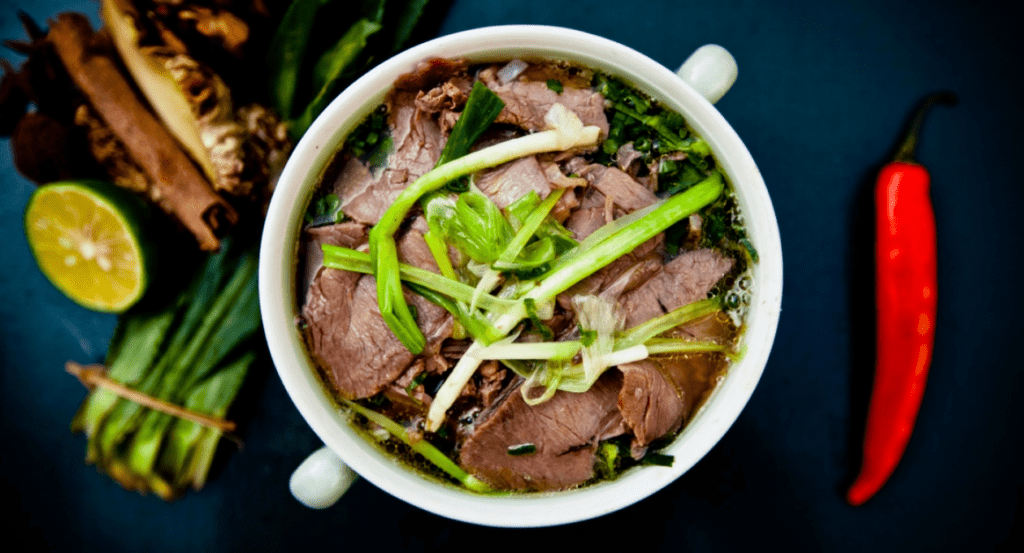
Thinly sliced beef or chicken, pho cakes, and broth (or broth as it is known in the South) are the major components of pho. Additionally, seasonings such as soy sauce, pepper, lemon, fish sauce, chili, and others are used. Depending on the preferences of each user, certain spices are added.
In the southern districts of Vietnam, pho is served with additional components known as herbs, including onions, racks, and coriander, basil, and other leaves; coriander being the traditional leaf used in pho. Pho is typically beef noodle soup, but other varieties include chicken, pig, shrimp,…
Pho restaurants may be found all around Vietnam, from the south to the north. The chef will put together each bowl to serve diners while being enveloped in steam clouds. The soft rice noodles and sliced meat are layered with the boiling broth, which is then sprinkled with chopped chives and a small amount of herbs. Each diner will personalize their bowl with a lemon grater, red pepper slices, basil sprigs, and dipping in hoisin sauce to their liking. You’ve inadvertently helped to build a great tour through Vietnam by having this experience!
3. Bún chả (Noodle with grilled pork)
Vietnamese cuisine known as “bún chả” consists of noodles with grilled pork, pickles, and fresh herbs. Fresh white rice vermicelli is referred to as “Bún,” and charcoal-grilled pig belly and meatballs are referred to as “Chả.” The excellence of the dish is undoubtedly determined by the two fantastic main ingredients that are presented with the irresistible dipping sauce, which also contains fish sauce, vinegar, honey, garlic, fiery chiles, and black pepper.
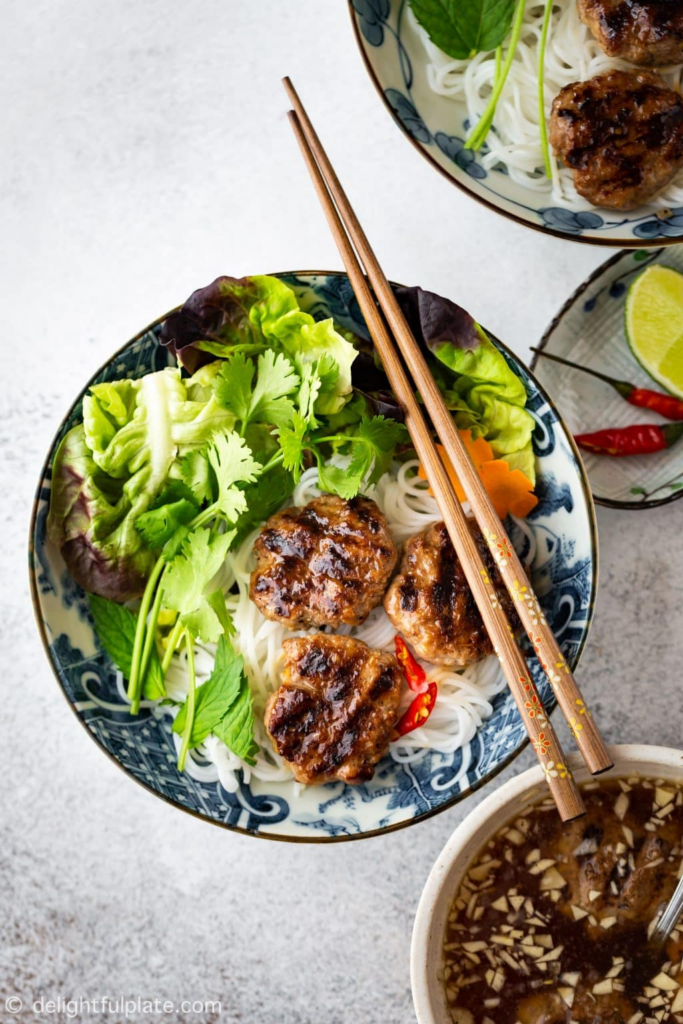
In Hanoi, bun cha is available in a wide variety of forms. Some shops have more or less invented their own styles by varying the preparation process and consumption time, such as serving vermicelli noodles for breakfast or vinegar vermicelli noodles.
Bun cha is typically consumed at midday. The choice of when to consume bun cha appears to be a matter of timing: choosing the right time to eat bun cha. A significant aspect that might affect the nutritional content of food is how it is consumed. You can eat more slowly, chew your food for a longer period of time, and ultimately improve your digestion and assimilation of nutrients without overtaxing your digestive system by utilizing chopsticks, using numerous plates, and sharing with others. One dish that is best shared and consumed with family is bun cha.
4. Bánh Đúc nóng (Steamed Rice Cake)
Rice cake is a traditional fork dish in Vietnamese cuisine that originates from the country’s northern region. Each region’s rice cake has a unique flavor and regional features. As a representation of the lyrical nature of Hanoians, the steamed rice cake of Hanoi in particular has a flavor all its own.
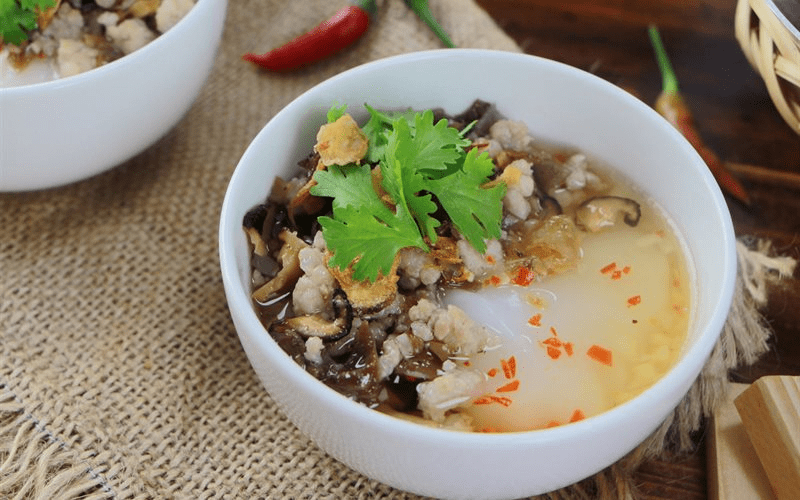
The steamed rice cake is a thick traditional cake made with rice flour and clear lime water that is typically cooled before being cut into square pieces and dipped in cork sauce (tương bần). When eaten, the crispy cake is covered with rich soy sauce, served with a variety of basil, perilla and chan in the water with the aroma of roasted sesame peanuts. This combination will give you great taste buds!
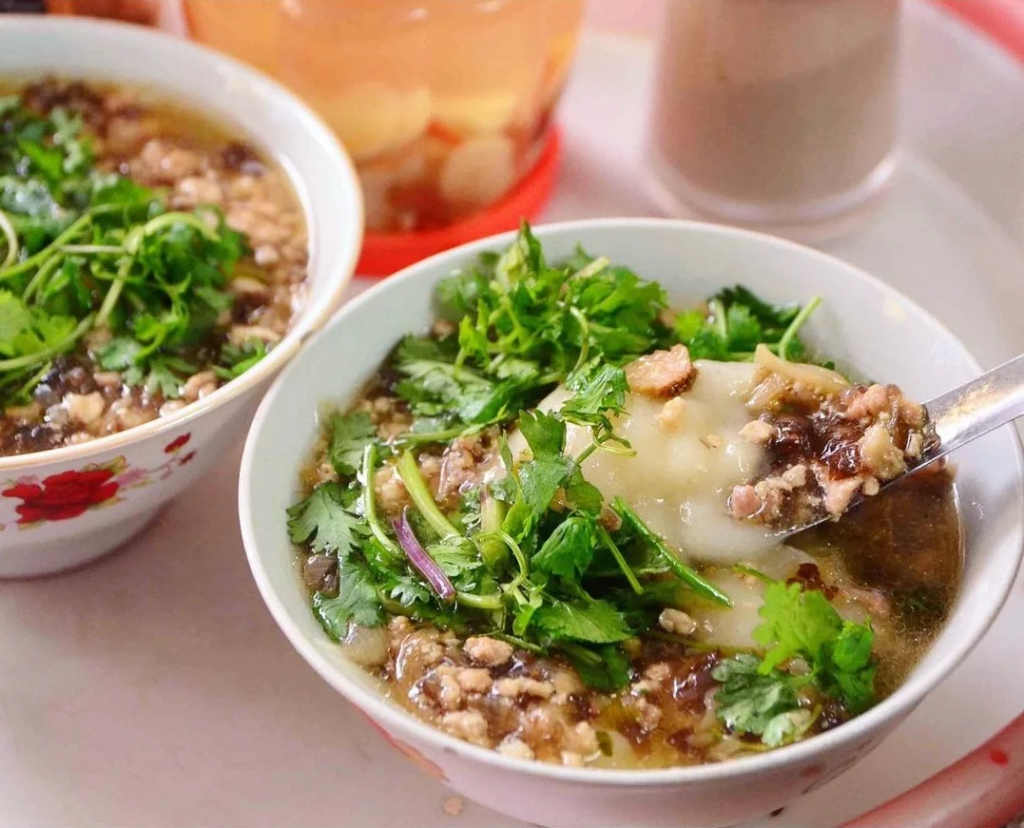
Moreover, a ladle of minced meat will be stir-fried with carpentry in each bowl of hot steamed rice cake. The meat will be lean or have minimal fat chips, and the aroma of the stir-frying will be fragrant. It blends seamlessly with the silky smoothness of the rice cake, slicing the crispy point into the crunch. A bowl of hot, sweet-and-sour fish sauce with cilantro will be placed inside the store. The fish sauce and fragrant stir-fry gravy combine to create a naturally sweet taste when consumed with the broth that permeates the steamed rice cake.
Vietnamese people typically provide steamed rice cakes as lunchtime snacks. Monsoon afternoons, eating a bowl of steaming rice cakes were quite chilly. The ethereal and delicate version of the rice cake that is linked with the lovely Hanoi city is now obtainable. It is a present for cold winter evenings when people yearn for a little something to enjoy that isn’t too filling but is still hearty enough to warm the stomach.
5. Bánh mỳ (Bread)
One of the symbols of the essence of Vietnamese food is “Banh Mi,” a beloved moniker that has become deeply ingrained in the thoughts of many Vietnamese people. Vietnamese bread has made its impact on international cuisine despite many ups and downs in the nation’s past.
Vietnamese food called banh mi has a bread-like outer shell with crispy exterior and soft intestines, and a filling inside. A number of bread fillings are available for one to select from, depending on regional culture or personal tastes. Traditional fillings, on the other hand, frequently include silk rolls, meat, fish, vegetarian fare, or fruit jams, along with a variety of supplementary components such patties, avocados, onions, peppers, and bread. Bread has gained popularity as a food among many people due to its affordable price.
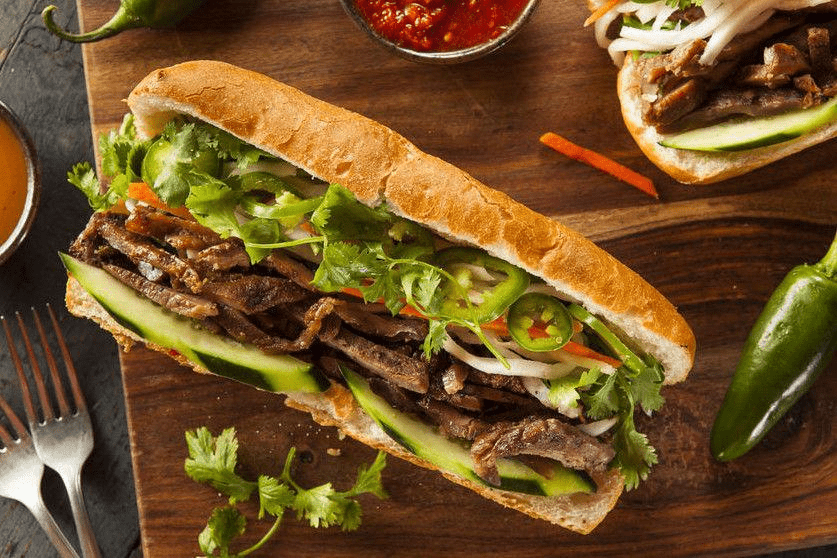
The idyllic cakes that are currently being sold on the streets of big cities and rural areas are exciting many foreign diners. Before being filled, the golden loaves are crisp-baked on embers to delight anyone who sees them. People no longer view bread as a side dish, but rather as the main course for everyone; meanwhile, cake is delectable, inexpensive, and extremely handy.
To say that bread is a proud emblem of the Vietnamese people is not an exaggeration. Saigon banh mi was named one of the top 10 greatest and most enticing street foods in the world in March 2012 by The Guardian’s travel website. CNN named Hoi An banh mi as the “King of Bread of the World” in 2018, and most recently on March 24, 2020, Vietnamese bread was still given honors when it was displayed on the Google homepage interface in more than 10 countries.
6. Bánh Cuốn (Steamed rice rolls)
In Vietnam, bánh cuốn is a widely consumed food. A mixture of cooked, flavored ground pork, finely minced wood ear mushrooms, and finely minced shallots make up the filling for bánh cuốn. The sides for this dish often contain chả lụa (Vietnamese pork sausage), cucumber slices, and bean sprouts in addition to the dipping sauce, which is fish sauce (nước mắm).
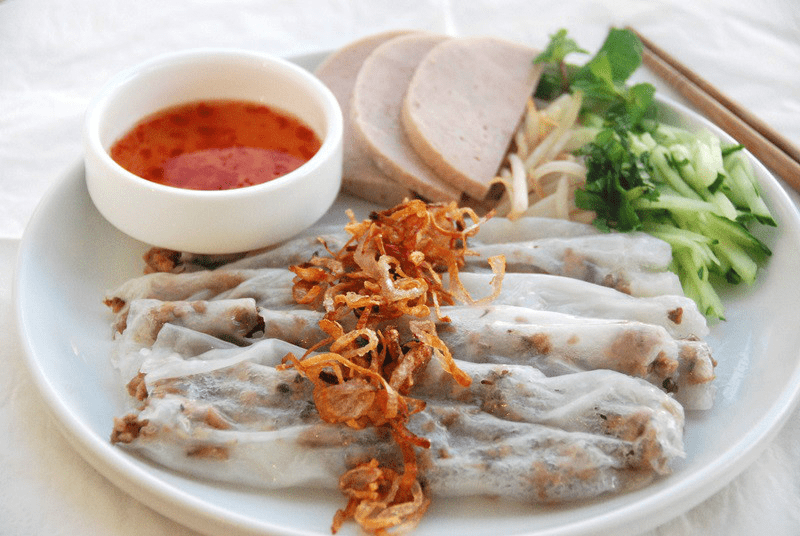
Due to the popularity of rolls among Vietnamese people as well as foreign tourists, it is common to see bánh cuốn on Vietnamese streets. Just take it all in, and the taste of bánh cuốn will stay forever in your mind
You want to eat as many freshly steamed rice wrappers as you can because of their warmth and delicious crunch. Vegetables and pork combine to make a delicious filling. There is always a fresh pile of bean sprouts, herbs, and different sides, all of which are meant to be dipped or drizzled in prepared fish sauce. I will undoubtedly be more enthusiastic than ever about bánh cuốn, the alluring meal from Vietnam.
Bánh cuốn are similar to a gift that each individual associates with their childhood; each thin slice of cake is expertly coated by artists to be cool and velvety. This dish has been deeply ingrained in Vietnamese culture, like a refreshing breeze to cool off during the sweltering summer months..
7. Nem rán (Spring rolls)
It is a well-known dish with a variety of names. It is known as “nem rán” in the North of Vietnam, “chả ram” in the Central provinces, and “chả giò” in the South. It is known as “spring rolls” in English-speaking nations.
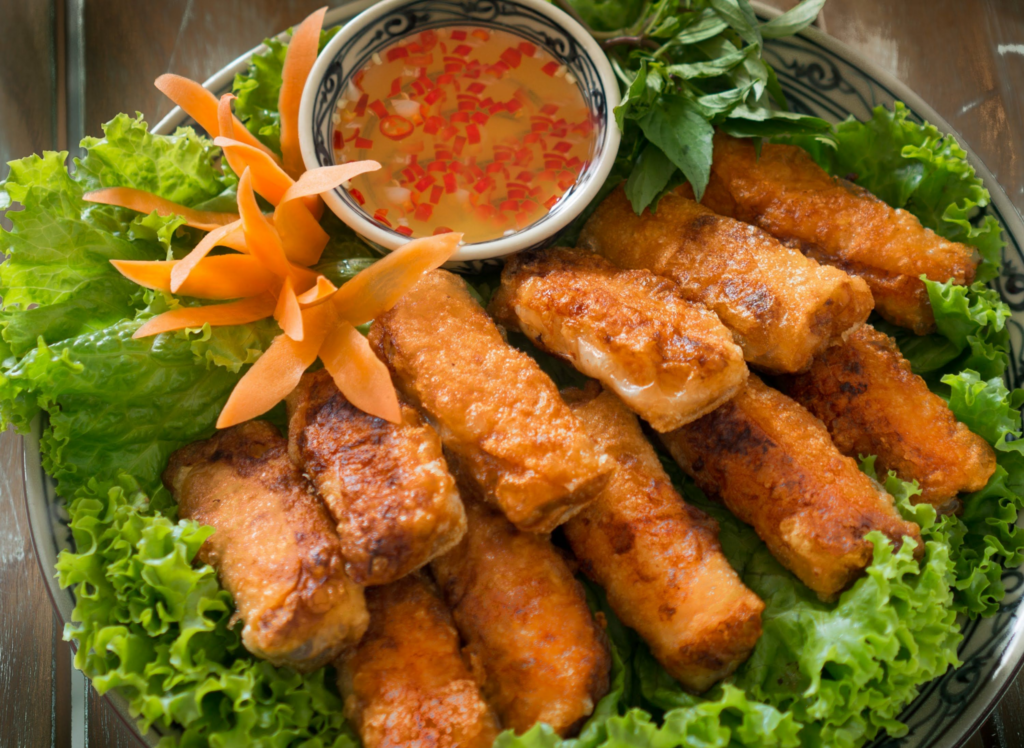
It is more of a philosophy or process than just a meal because there are so many variations and versions among different locations, communities, and even families. Coastal regions typically add shrimp and/or crab, and versions from the Vietnamese diaspora typically contain even more variations depending on their history and local conditions. Northern versions are almost always made with rice paper and include kohlrabi, while Southern versions can be made with flour wrappers and include taro.
The dipping sauce is essential whether you eat these mouthwatering rolls by themselves or combine them with bn noodles to produce “Bún nem.” Because they need so much planning, making nem rán at home always feels like a special occasion. We consume them during family gatherings, on special occasions, and almost exclusively during Tât Niên, the family feast held the night before Tât, the Vietnamese/Lunar New Year.
8. Bún bò Huế (Hue beef noodle soup)
Bún bò Huế is a lesser-known Vietnamese delicacy that hasn’t quite “made it” in popular American cuisine. It’s a thick, flavorful soup with a kick of heat. With plenty of fresh herbs on top, this Central Vietnamese soup is served with soft beef and pork chunks.
Although this noodle dish is well-liked throughout all three regions of Vietnam as well as among Vietnamese living abroad, bun bo is one of Hue’s specialties. Vermicelli, beef corn, pork spring rolls, a broth with a distinctive red color, lemongrass, and citronella are the dish’s key ingredients. Depending on the cook’s tastes, noodle bowls are occasionally incorporated into beef rolls, crab rolls, and other components.
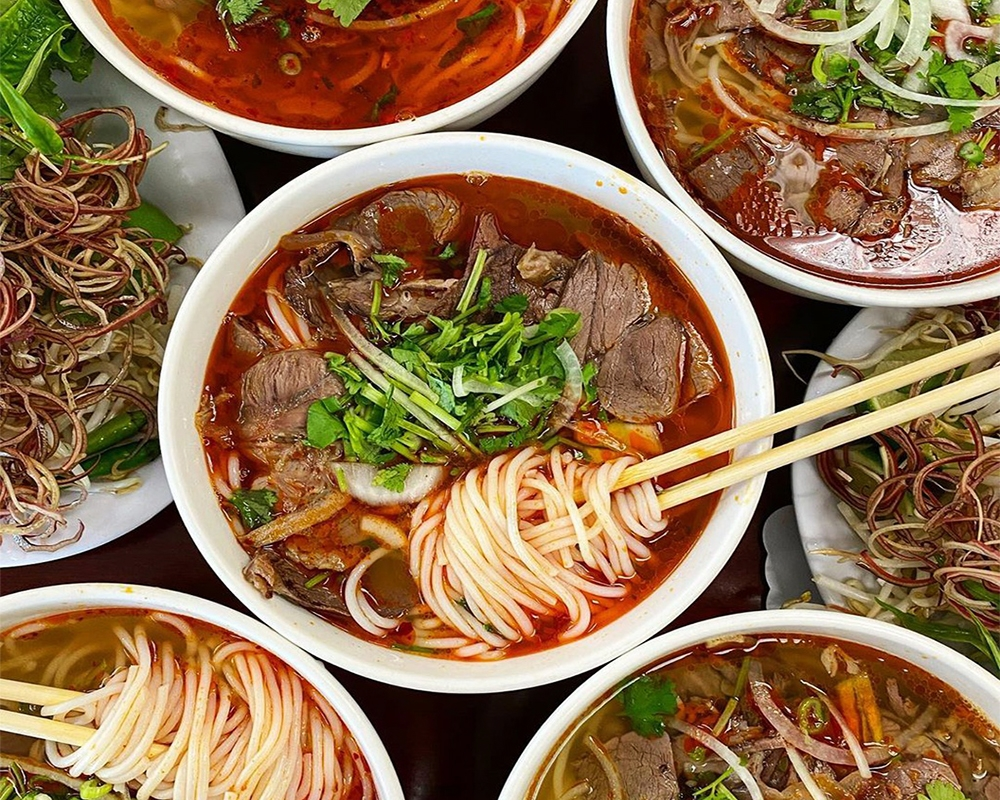
Eat the dish in a bowl with the soup and broth, top it with the following vegetables: mint, Thai basil, bean sprouts, and banana blossom, and then add however much or little meat you desire. The vegetables make it slightly healthier and also help the soup cool down.
9. Bánh Bèo chén (Bloating Fern-shaped cake)
In addition to being well-liked in Southern Vietnam, bánh bèo, a cake from the Ancient Capital of Hue, is also well-liked in the Central part of the country. For many years, Vietnamese people’s culinary culture has regarded Bloating Fern-shaped cake as a culinary masterpiece. The name “bánh bèo” may have originated from the cake’s resemblance to a duckweed tree leaf.
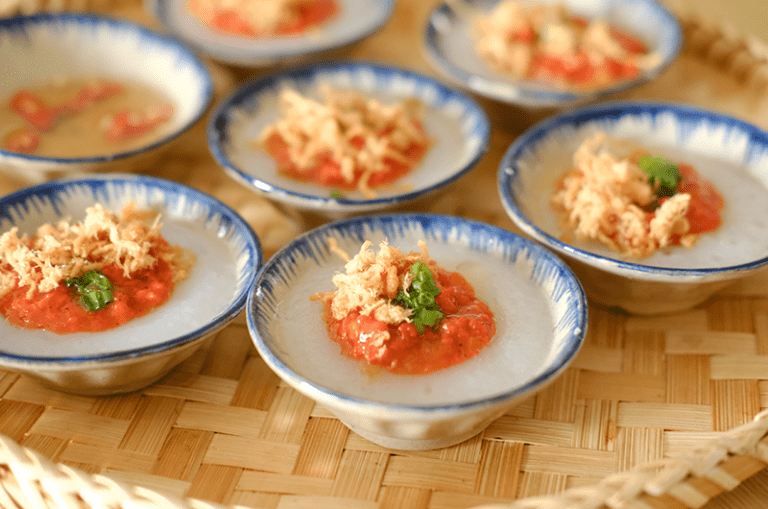
The three major components of Bloating Fern-shaped cake are a rice flour cake, a shrimp puree filling to sprinkle on top, and dipping sauce. Fish sauce is the main component of the dipping sauce, which is typically poured directly onto the cake rather than dipping. When mashed roasted peanuts and onion fat are added, the cake improves in appearance and flavor. There are several ways to add and remove this cake depending on the region. For instance, in Saigon, it is typical to remove green beans and sour foods and replace them with molded cakes, small cakes, and filtered flour cakes.
Taking pleasure in Banh Beo Hue, one of the most well-known dishes in Hue cuisine, turns it into a lyrical cultural activity. Visitors to Hue who have not yet located Banh Beo chen will have something important to regret.
10. Cao lầu
Vietnamese noodle dish cao lau is popular in Quang Nam. This noodle meal is made of yellow noodles, shrimp, pork, fresh veggies, and a very small amount of liquid. Ash from a nearby plant will be combined with the yellow noodles.

In order to create a bowl of Cao Lau, the chef first cuts a portion of the high-rise yarn into short pieces, deep-fries it to create a “clove,” then roasts it with peanuts while it is coated in gold, and finally sprinkles that “clove” on top of the tall fibers that have been thickly spread in the bowl. The chef then began to spread the sauce around the bowl’s mouth while laying small pieces of bright pink fruit with a red border.
The rich aroma of fat cloves combined with the sweet aroma of shrimp, shredded meat, mixed with all the pungent, bitter, and acrid flavors of vegetables, along with the sound of the noodles, the aroma of fish sauce, soy sauce, and other flavors, can be said to help diners awaken all of their senses while eating Cao Lau. The only place where the meal may be tasted after is in Hoi An.
11. Nem nướng Nha Trang (Nha Trang Grilled Sausages)
The mouthwatering flavor of Nha Trang grilled spring rolls is something that everyone who visits must remember forever in addition to the city’s abundance of stunning beaches.
The main ingredients for Nha Trang grilled spring rolls are tenderloin, rice paper for rolling, raw vegetables for serving, and a bowl of delectable dipping sauce.
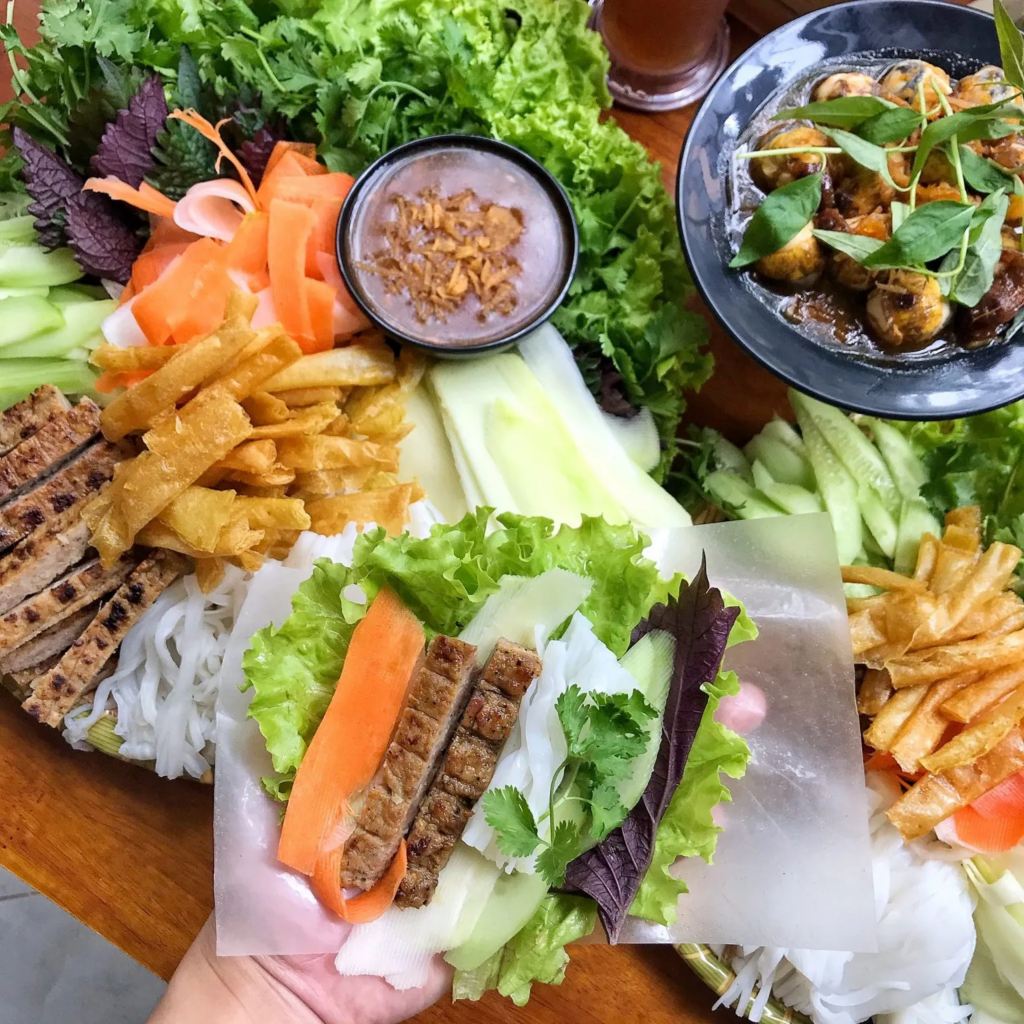
Equally crucial is learning how to produce the dipping sauce for Nha Trang’s grilled spring rolls. Bowls of soy sauce are created with spices in accordance with each chef’s personal family recipe, giving them an array of appealing sour, salty, and sweet flavors. Glutinous rice, soybeans, tomatoes, shrimp, lean meat, and pork liver puree blended with sugar, garlic, and peppers are the major ingredients in this mouthwatering dish of dips.
With all that complexity, the result is a rustic yet endearing dish that entices customers right away. A distinctive grilled spring roll from Nha Trang will surely appeal you immediately!
12. Bánh xèo (Pancake)
The crispy, packed rice pancake known as bánh xèo, or Vietnamese crêpe, is very well-liked in Vietnam. The name alludes to the sound the sizzling rice batter makes when it is thrown onto the hot skillet (from the word xèo). Using rice flour, water, and turmeric powder, it makes a savory fried pancake. Pork, prawns, sliced green onion, mung beans, and bean sprouts are a few typical stuffing ingredients. Along with lettuce, mint, Asian basil, and fish mint, bánh xèo is served to customers by the most appealing appearance.
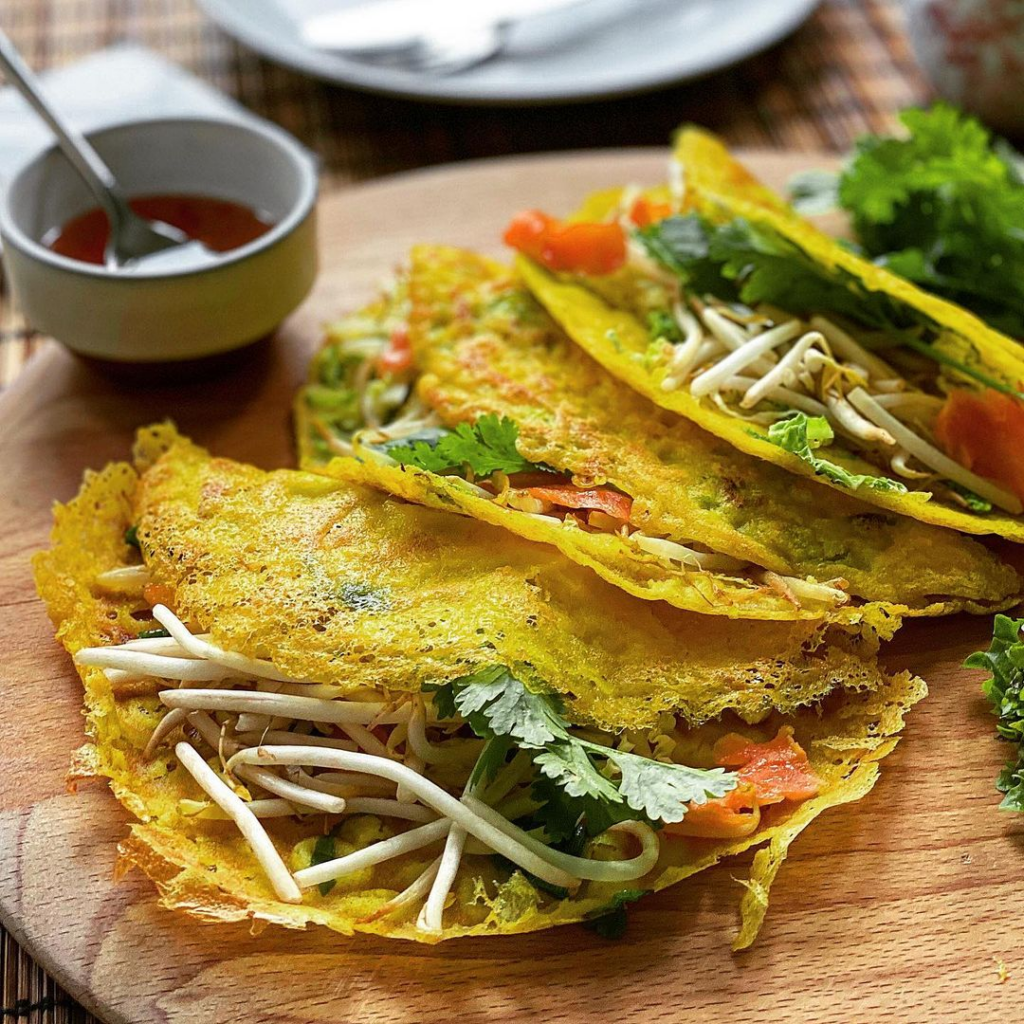
Although these yellow crêpes resemble omelets, they actually don’t contain any eggs. They are only made yellow with turmeric powder! The perfect cuisine for cozy family gatherings, this crowd-pleaser is a hot-off-the-pan, hands-on food meant to be wrapped in vegetables and dipped in a rich sauce.
13. Bánh canh cua (Crab noodle soup)
Saigon cuisine is known for its dishes like crab noodle soup. The fresh taste of the crab flesh and the thick broth that permeates the noodles make the Banh Canh a favorite among diners. Therefore, it is not difficult to locate a restaurant serving this cuisine if you wish to try it in Saigon.

The dish is made more appealing by the sweet broth made from bone that was cooked with a mixture of fragrant crab roe in the natural color of cashew oil. Peeled shrimp, crab meat, fish cake, lean meat, and scallions are all included in a bowl of banh canh. When customers call, the cook will put the cleaned and peeled crabs in a hot patch and soup so the crab meat won’t be friable but will still be fresh.
The dipping sauce has a distinct flavor that is unique to this location. The soup is made more palatable by diluting the rich fish sauce with lemon, chilli, and sugar to create a harmonizing salty and sour flavor. After enjoying the soup, continue to eat the boiled crab meat and shrimp while dabbing the flesh with fish sauce.
14. Bánh Khọt (Khot cake)
The best substitute for tiny savory pancakes in Vietnam is bánh khọt! They have a seriously crispy golden batter that you can hear as you bite into them. They are light and delicate. Enjoy them rolled in lettuce and fresh herbs for a truly authentic meal that will transport you to Vietnam’s culinary scene!
The flour is created from a mixture of largely leftover rice grains and rice flour, as well as a little turmeric to give them a lovely golden hue. Coconut milk is then added to the mixture to make the flour more rich and creamy. Finally, the toppings are typically diced green onions and shrimp.
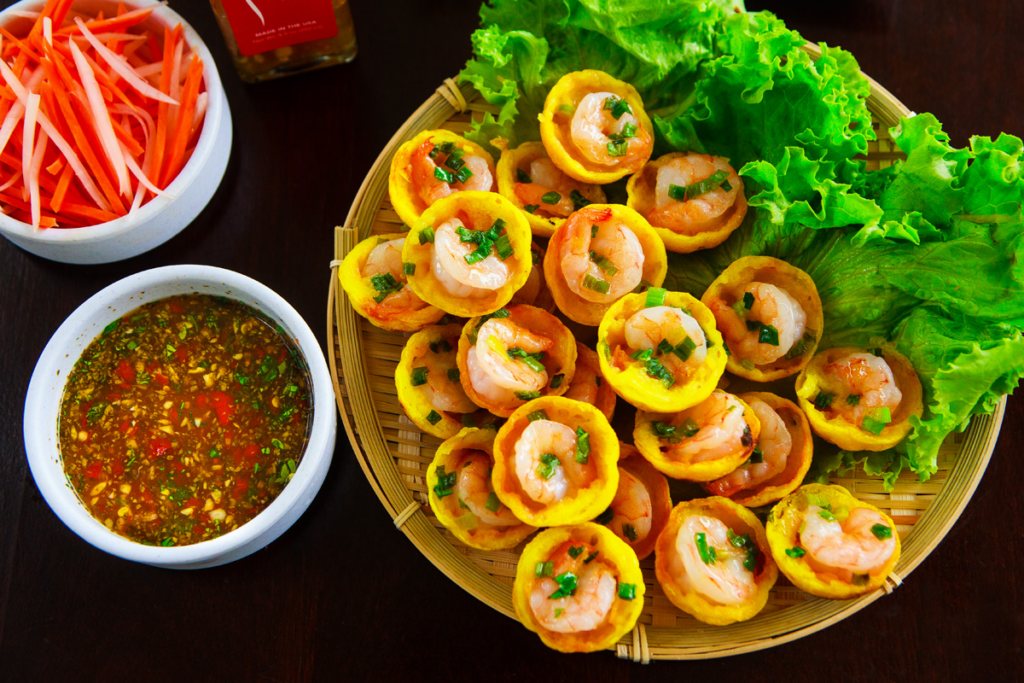
The basic method for eating is to take one of the wider leaves like a mustard greens leaf for instance, hold it in your palm, then take a mini pancake, place it in the middle, layer it with extra herbs, kind of wrap the entire agglomeration into a spring roll shape (or however it turns out), and then dip into the Vietnamese fish sauce dressing.
As soon as you bit into the wobbly leaf wraps, which had a crispy pancake concealed in the center, you tasted the leaves’ lovely crisp freshness, the banh khot’s crunch, and then the batter’s and topping’s smoothness.
Although it was created simply, this specific dish of crispy Vietnamese street food pancakes is likely to send your taste buds skyward.
15. Bun mam (Rice vermicelli soup)
One of the regional specialties of the southwest of Vietnam is bún mắm. Fish sauce or choke fish, which are plentiful in the West, particularly in the provinces of Tra Vinh and Soc Trang, are used to prepare bun fish sauce.
The water is what makes fish noodles distinctive. Each person’s preferred flavor is added to the water, which is typically produced from fish sauce or choke fish, giving the noodles a rich scent. Typically, split spinach, cotton stalks, bitter vegetables, banana corn, trusses, racks, and lettuce are served with fish noodles.
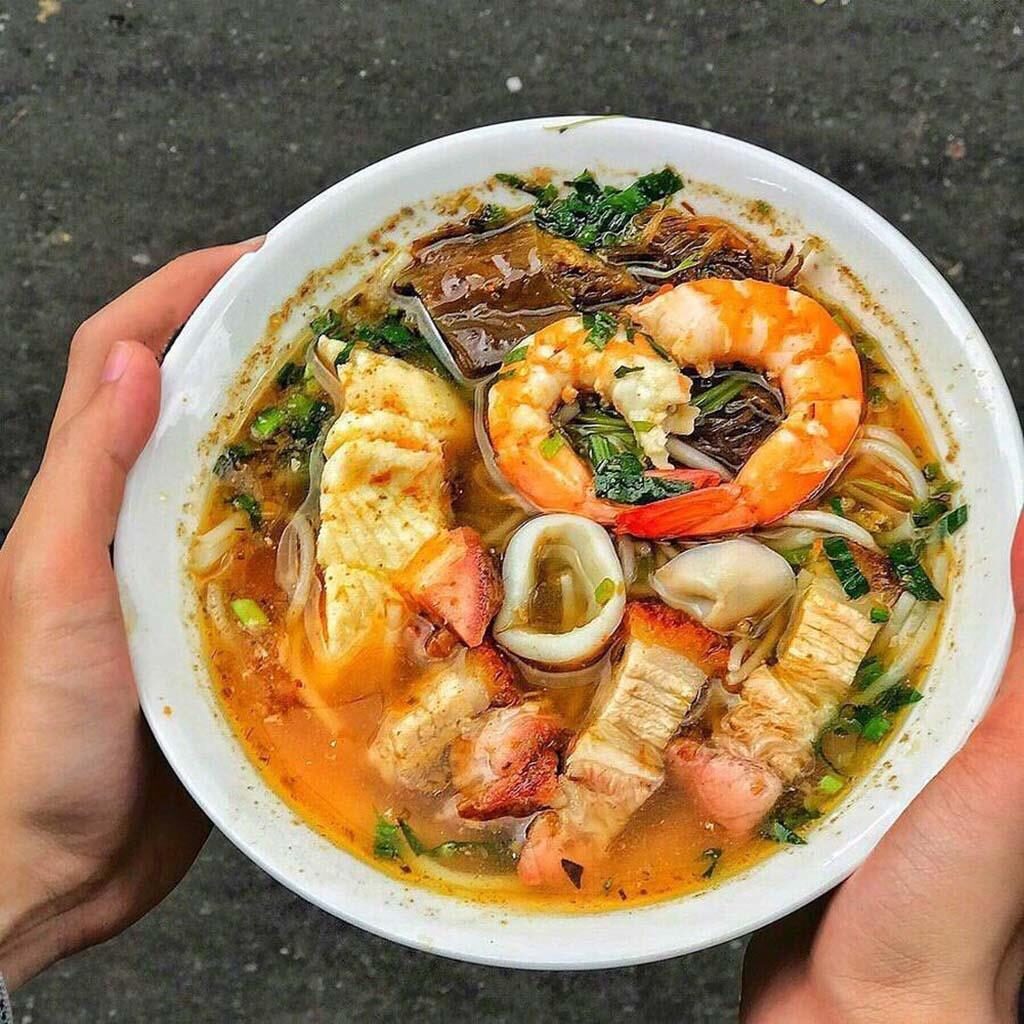
A plate of veggies and a bowl of smoked fish noodles are served alongside fresh seafood and a dash of lemon to enhance the aroma. Customers are welcome to eat the vegetables either raw or by asking the proprietor to blanch them. In the table’s corner, tasting wedges are also available for customers to chop up however they choose.
The top 15 dishes on the aforementioned list are favorites among Vietnamese people. We are completely aware that trying novel food in a foreign country might be perilous; undoubtedly, people with weak stomachs should think carefully before doing so. But don’t worry, the Xin Chao team of locals is always available to listen, assist you with your planning, and offer the most sincere recommendations that will ensure that your trip to Vietnam includes the best possible exposure to local cuisine.
